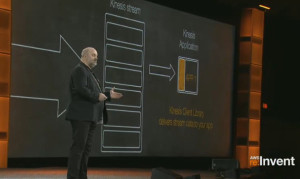 Amazon Web Services this week released its new cloud-based data analytics tool Kinesis, which can analyse large amounts of data in real time and be paid for by the hour.
Amazon Web Services this week released its new cloud-based data analytics tool Kinesis, which can analyse large amounts of data in real time and be paid for by the hour.
Kinesis is an application that sits in the cloud and receives data from a number of sources: databases within Amazon’s cloud, like warehouse tool Redshift; NoSQL database DynamoDB; or relational database RDS. It then performs analytics on the data and spits out returns on the data. AWS developed the program using its own combination of hardware and software. The system is scalable too, able to handle several terabytes of data an hour from thousands of sources.
In announcing the tool at re:Invent, the company’s customer conference, AWS showed off how Kinesis can be used to analyse thousands of updates to Twitter in real-time, allowing queries to be performed on the data. For example, Kinesis was able to pinpoint the most popular word that was tweeted within an hour-long timespan of Tweets that were uploaded into the system. The data that Kinesis generates can then be offloaded into one of Amazon’s storage platforms like Simple Storage Service (S3). It could also be used to analyse real-time financial transactions, in-bound marketing or metering data, for example.
The new service compliments data analysis tools that AWS already has. RedShift, for example, has the ability to run analyses on data stored there, but it’s meant for longer-term data that is stored in its cloud. Kinesis is meant for rapid, real-time analysis of data.
Kinesis also fits in well with a growing number of Amazon partner companies who offer tools to help make sense of data that AWS analyses. Jaspersoft, for example, is a company that can take the results of queries that RedShift has done and create visualisations from it and set up alerts. That sort of platform is a natural fit for being able to provide customers actionable insight from analysis that AWS performs.
The move represents AWS’s continued push into giving customers more options for analyzing their data as well. AWS already has a Hadoop system named Elastic Map Reduce (EMR), which is a pay-by-the-hour Hadoop cluster. S3 has scaled to store trillions of objects in AWS’s cloud. Having new tools to be able to run analytics jobs on all that data is an area experts were expecting AWS to make announcements in at re:Invent.





